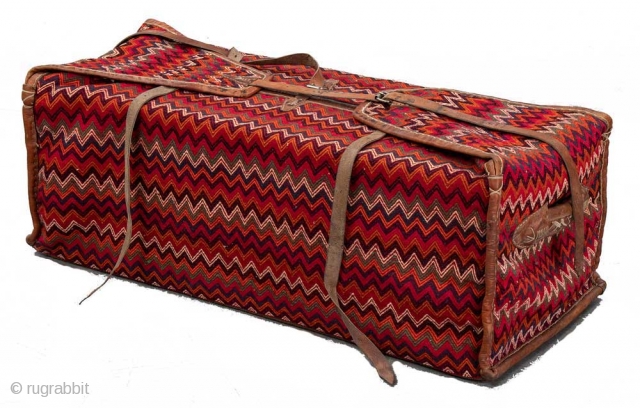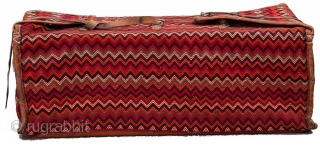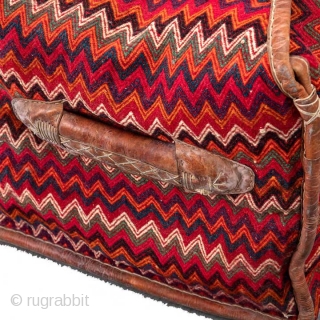Back
Mafrash are primarily from eastern Turkey, far north western Iran (Persia) and the southern Caucasus, although they are not only made there. They are woven 'three-dimensional' rectangular bags hand made originally by nomads in a 'box' like form - often in matching pairs - comprising one long piece that 'wraps' around the bag that encompassed both sides, the bottom - which is often of a different design as seen here - and the top (with no joins at the corners / edges), and two shorter separate end panels. When assembled, where the end panels where joined onto the long panel (that comprised sides, bottom and top described above) the join at the edges were usually covered / edged in leather as in this example. a handle, here also leather, was sewn onto either end also. Used for storage of bedding, etc, and as cargo carriers when traveling, the contents were secured by the leather straps seen in the photos. Unfortunately, in today's world in the countries mentioned above and elsewhere they are made / used, their users have often gone to 'plastic' type bags / sacks purchased via the bazaar, which take much less 'work', hence cheaper than weaving to purchase / posses. Today, collectors in the 'west' often display them as 'tables', with the bag encapsulating wooden boxes or a supporting center structure to make them rigid. Size 106cmL x 45cmW x 42cmH (41.75" x 17.75" x 16.5"). This beautiful mafrash, made circa the 1930's, has a 'dazzler' type design and is in very good condition.
price:
Price on request
- Home
- Antique Rugs by Region
- Category
- Profiles
- Post Items Free
- Albums
- Benaki Museum of Islamic Art
- Budapest: Ottoman Carpets
- Gulbenkian Museum
- Islamic Carpets. Brooklyn
- Islamic Textiles. Brooklyn
- Konya Museum: Rugs
- MKG, Hamburg
- MMA: Caucasian Carpets
- MMA: Mamluk Carpets
- MMA: Mughal Indian Carpets
- MMA: Ottoman Carpets
- MMA: Safavid Persian Carpets
- MMA: Turkmen Rugs
- McCoy Jones Kilims
- Ottoman textiles. Met
- Philadelphia Museum
- Rugs and Carpets: Berlin
- Seljuqs at the Met
- TIEM, Istanbul: Carpets
- V&A: Classical Carpets
- Vakiflar Carpets: Istanbul
- Baluch Rugs: Indianapolis
- Gallery Exhibitions
- Jaf an Exhibition
- Alberto Levi Gallery
- Andean Textile
- Christie's London: 2016
- Francesca Galloway
- HALI at 40
- ICOC Washington, DC 2018
- Jajims of the Shahsavan
- London Islamic Week April, 2018
- Mongolian Felts
- Navajo Rugs: JB Moore
- Persian Piled Weavings
- SF Tribal & Textile Art Show 2020
- SF Tribal 2019
- Sotheby's: C. Alexander
- Turkish Prayer Rugs
- Turkmen Main Carpets ICOC 2007

















